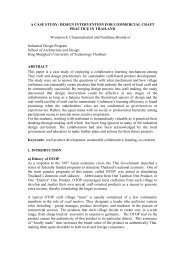soa+d research manual - School of Architecture and Design, KMUTT
soa+d research manual - School of Architecture and Design, KMUTT
soa+d research manual - School of Architecture and Design, KMUTT
Create successful ePaper yourself
Turn your PDF publications into a flip-book with our unique Google optimized e-Paper software.
it is hardly worth doing. Research implies originality, discovery<br />
<strong>and</strong> an encounter with the unknown. broadly speaking, the<br />
outcome <strong>of</strong> scholarly <strong>research</strong> is ‘knowledge’. Research projects<br />
produce, enhance or critique knowledge <strong>and</strong>, by doing so, may<br />
serve a number <strong>of</strong> purposes. for example, knowledge may be applied<br />
or transferred to address real world problems or opportunities.<br />
Knowledge arising from <strong>research</strong> may make a contribution<br />
to discourse or practical underst<strong>and</strong>ing within a field or subject.<br />
Knowledge may even be created with no immediate application<br />
in mind but in response to the curiosity <strong>of</strong> a particular <strong>research</strong>er<br />
or <strong>research</strong> team. Whichever the case, <strong>and</strong> whatever its final<br />
form, the knowledge that results from academic <strong>research</strong> is<br />
published in an appropriate forum <strong>and</strong><br />
scrutinized by academic peers.<br />
TYPES OF RESEARCH?<br />
At the risk <strong>of</strong> oversimplification, the major types <strong>of</strong> <strong>research</strong><br />
relevant to art, architecture <strong>and</strong> design are as follows:<br />
Basic Research<br />
basic <strong>research</strong> is also known as fundamental or pure<br />
<strong>research</strong>. it is motivated by curiosity rather than a desire to create<br />
some new application or innovation. for example, speculative<br />
<strong>and</strong> open-ended inquiries into forms, structures, materials,<br />
processes, representations might be seen as basic <strong>research</strong> in<br />
our fields. Whilst knowledge is acquired for its own sake, practical<br />
applications <strong>and</strong> innovations frequently emerge from insights<br />
gained through basic <strong>research</strong>.<br />
Applied <strong>research</strong><br />
Applied <strong>research</strong> is driven by the desire to solve practical problems<br />
<strong>and</strong> meet human needs in some way. much conventional<br />
architectural <strong>and</strong> design <strong>research</strong> is ‘applied’ in this sense. for<br />
example, ergonomic, psychological <strong>and</strong> socio-cultural design<br />
<strong>research</strong>, are—each in their own ways—directed towards<br />
enhancing existing spaces, products <strong>and</strong> systems, or developing<br />
innovations that fit actual or potential human needs.<br />
Action <strong>research</strong><br />
Action <strong>research</strong> aims to facilitate organizational, social or<br />
cultural change. for our purposes, participatory approaches to<br />
design <strong>and</strong> community development or <strong>research</strong> that revolves<br />
around teaching <strong>and</strong> learning, might be seen as exemplars <strong>of</strong><br />
action <strong>research</strong> in the fields <strong>of</strong> architecture, art <strong>and</strong> design.<br />
Practice-based <strong>research</strong><br />
in practice-based <strong>research</strong>, the materials to be studied are<br />
REsEARch iN ARchiTEcTuRE, ART & DEsigN<br />
created by the practitioner during the course <strong>of</strong> the project.<br />
Practice-based <strong>research</strong> is a form <strong>of</strong> inquiry into, through<br />
or about creative practice/ production. Whilst it is usually<br />
associated with the fine arts, its origins are in medicine, <strong>and</strong><br />
it is increasingly used in fields as diverse as creative writing,<br />
s<strong>of</strong>tware engineering <strong>and</strong> law.<br />
Theory <strong>and</strong> criticism<br />
Research in theory <strong>and</strong> criticism investigates the philosophical,<br />
historical <strong>and</strong> socio-cultural contexts <strong>of</strong> architecture, art <strong>and</strong><br />
design. such <strong>research</strong> plays an important role in the intellectual<br />
life <strong>and</strong> dynamics <strong>of</strong> the creative disciplines.<br />
WHY RESEARCH MATTERS<br />
Research is now a crucial aspect <strong>of</strong> academic life. it serves as<br />
one <strong>of</strong> a series <strong>of</strong> measures <strong>of</strong> quality <strong>and</strong> performance at institutional<br />
<strong>and</strong> individual levels. At an institutional level, <strong>research</strong><br />
output is taken as a measure <strong>of</strong> quality <strong>and</strong> is used to judge <strong>and</strong><br />
rank the university <strong>and</strong> school nationally. At an individual level,<br />
your own <strong>research</strong> is one <strong>of</strong> a number <strong>of</strong> scholarly activities that<br />
contribute to career progression <strong>and</strong> academic status. in the<br />
broader sense, <strong>of</strong> course, <strong>research</strong> matters through the various<br />
important contributions it makes to social <strong>and</strong> cultural development<br />
<strong>and</strong> the growth <strong>of</strong> knowledge.<br />
07



